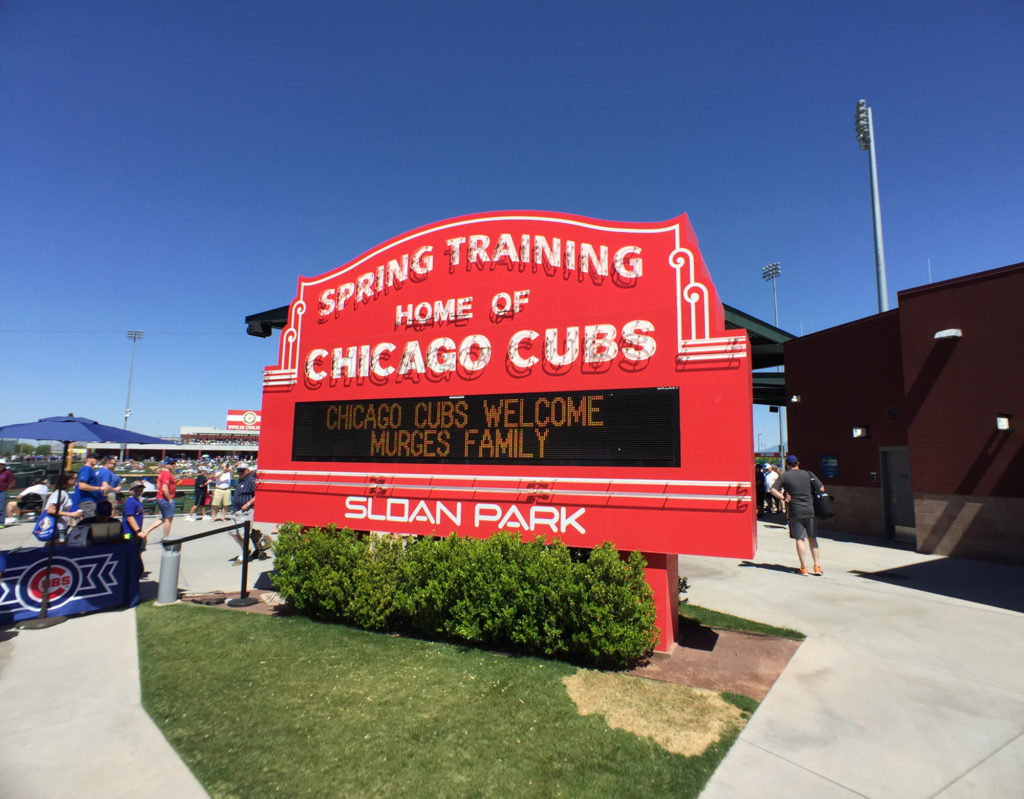The best marketing for a professional baseball team comes from fans, proclaiming their love of the sport. And how does this savvy marketing come these days? From selfie spots, where fans on Instagram, Facebook and Twitter share photos of unique ballpark features.
Here are some great examples of selfie spots that can be emulated in almost any ballpark. Though we’re focusing on MLB teams here, there are plenty of MiLB, independent, college and summer-collegiate teams employing these same selfie strategies. Really, every team should be eyeing some sort of selfie spot as a way to market their ballpark and their teams: these are not expensive promotional expenditures, and they allow an operator to stand out in increasingly crowded marketplaces.
Statues
Nothing evokes memories more than a statue of a beloved star in team history. They’ve been around for decades. After the Baltimore Orioles opened Oriole Park at Camden Yards–well before selfies were a thing, by the way–the team added a statue of Baltimore native Babe Ruth outside the ballpark in February 1995. The scale makes it a little hard to incorporate the Babe in a selfie, but newer ballparks have scaled back the historic figures and made them selfie-friendly. Target Field has statues of Kirby Puckett, Rod Carew, Tony Oliva, and Harmon Killebrew; PNC Park has life-sized statues of Honus Wagner, Roberto Clemente (both originally installed at Three Rivers Stadium), Willie Stargell, and Bill Mazeroski. You can find them at almost every MLB ballpark.
Retired numbers. When the Atlanta Braves opened up CoolToday Park and the Milwaukee Brewers unveiled American Family Fields of Phoenix this spring, designers included displays of retired numbers in front of main entrances, the better to entertain fans entering and leaving the ballpark. At CoolToday Park, the team’s retired numbers-#44 (Henry Aaron), #3 (Dale Murphy), #6 (Bobby Cox), #10 (Chipper Jones), #21 (Warren Spahn), #29 (John Smoltz), #31 (Greg Maddux), #35 (Phil Niekro), #41 (Eddie Mathews), #47 (Tom Glavine) and #42 (Jackie Robinson) are memorialized on the front plaza. Other teams have done the same in previous years: the Orioles have a set installed at Oriole Park, while the Red Sox have retired numbers displayed at both Fenway Park and JetBlue Park.
Giant Bobbleheads. What Los Angeles Dodgers fan doesn’t want to take a selfie next to a giant Tommy Lasorda bobblehead? And what Chicago White Sox fan doesn’t want to take a selfie next to a giant Frank Thomas bobblehead? Both can be found at Camelback Ranch-Glendale, the teams’ spring home.
Historic relics. When the Philadelphia Phillies unveiled renovations to Citizens Bank Park for 2019, they included something sure to resonate with fans: a 19-foot-high Liberty Bell that once sat atop Veterans Stadium, displayed it outside the newly renovated area. Now, Veterans Stadium wasn’t a great facility, but it was where the Phillies franchise was reborn behind the likes of Mike Schmidt and Larry Bowa. Adding a renovated Liberty Bell connects those glory days to today’s Phillies.
The iconic Wrigley Field marquee serves as a selfie spot at both Wrigley Field and Sloan Park, the Cubs’ spring-training home. It’s usually a tussle to get a good angle for a selfie with the red Wrigley Field marquee at the corner of Clark and Addison before a game. The marquee was replicated at Sloan Park and installed on the main concourse. In a brilliant move, Cubs officials will put up personalized messages on the marquee for those seeking the ultimate spring-training selfie.
Oversize logos. Honestly, these should be found outside every MLB and MiLB ballpark. We see them all the time in spring training: when the New York Yankees unveiled improvements to its spring-training home, Steinbrenner Field, an oversized iconic Yankee logo was installed at the new main entrance. The Houston Astros and Washington Nationals erected oversized logos at their spring-training home, FITTEAM Ballpark of the Palm Beaches.
There’s one side effect to these selfie spots: ensuring the ballpark has plenty of bandwidth to serve all these users. SunTrust Park, home of the Atlanta Braves, was designed to include plenty of selfie spots but also has the bandwidth to serve these selfie users. The team worked with telecom vendor Comcast on a robust WiFi system with dual 100GB of bandwidth (totaling 200GB, via 2 terabit ports)-enough for everyone in a sold-out ballpark to simultaneously post a selfie. On a Friday or Saturday with big crowds, the system is pushing 8.3 terabits of data. More data is being uploaded than downloaded, indicating plenty of selfies and game updates are being submitted to Instagram, Facebook and Snapchat.
Creating a selfie spot or two is a cost-effective way for a team to use today’s social media as a marketing tool. With a little imagination and strategic planning, adding a signature spot to a ballpark prompts fans to do your marketing for you.
This article first appeared in the Ballpark Digest newsletter. Are you a subscriber? It’s free, and you’ll see features like this before they appear on the Web. Go here to subscribe to the Ballpark Digest newsletter.





